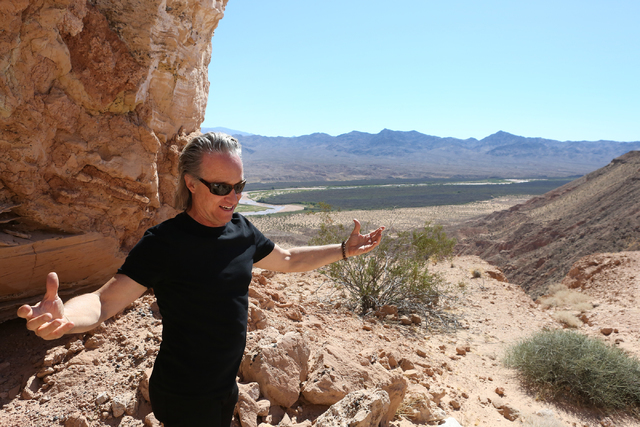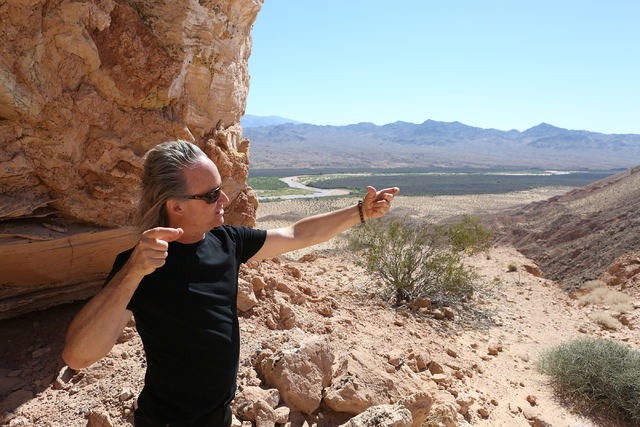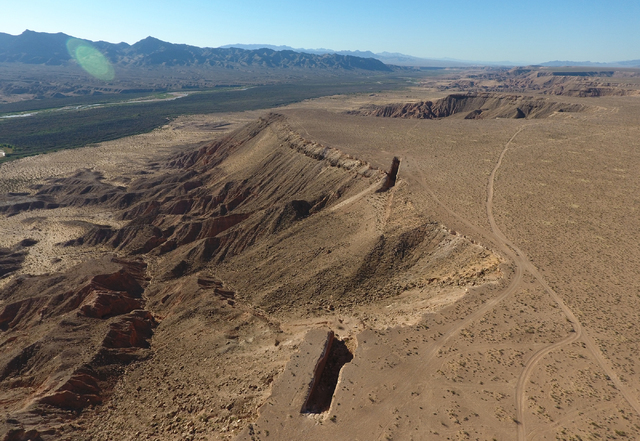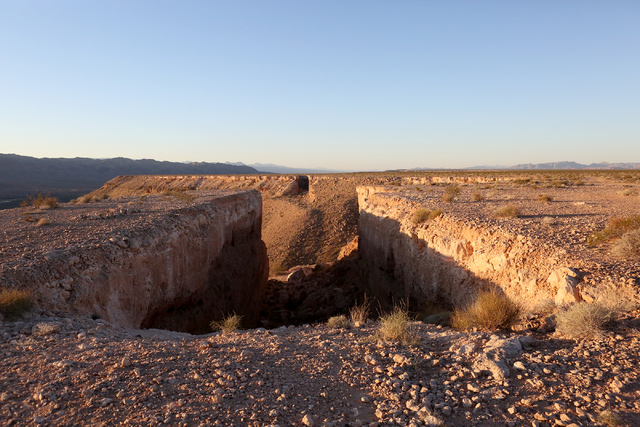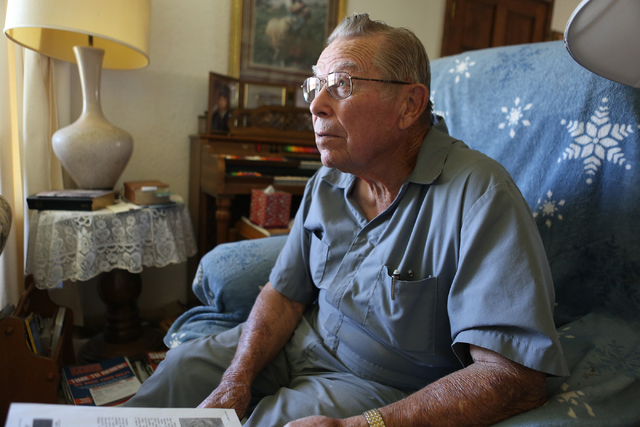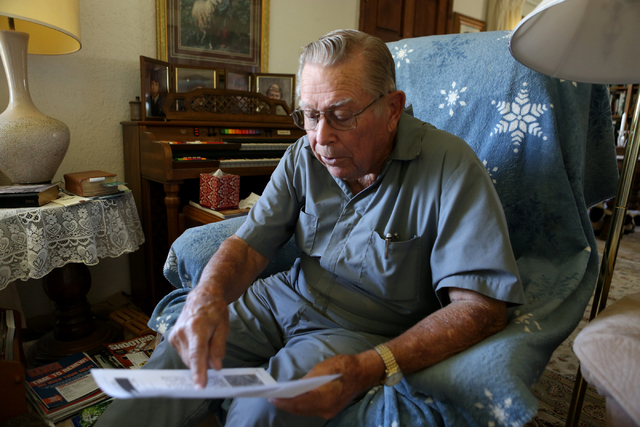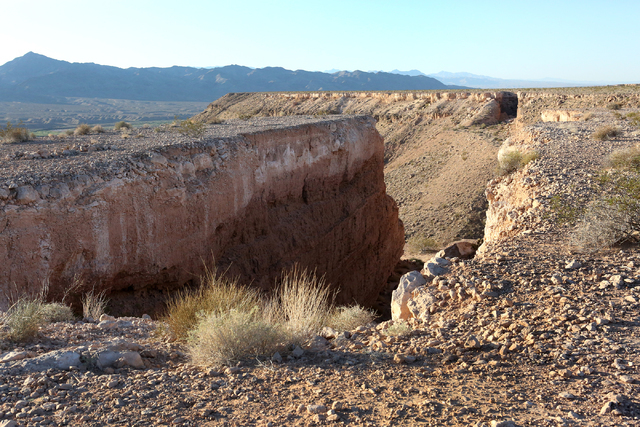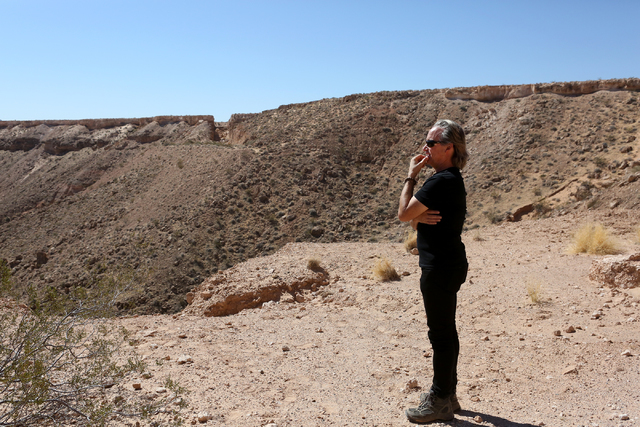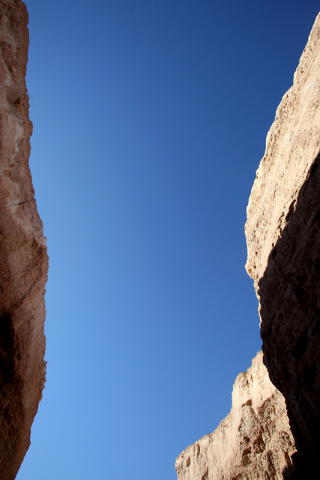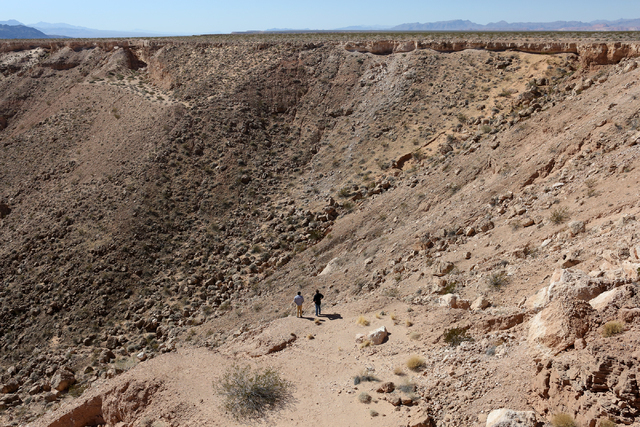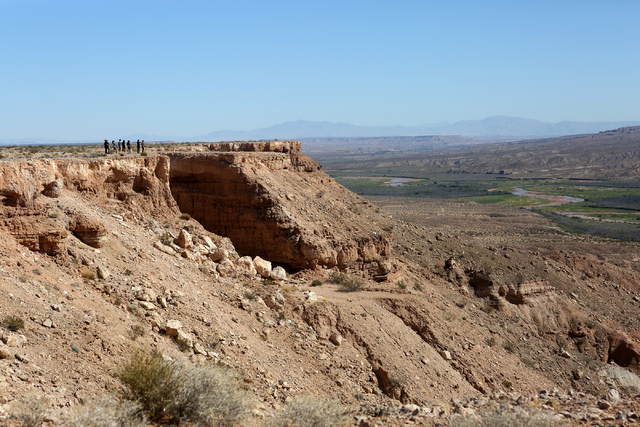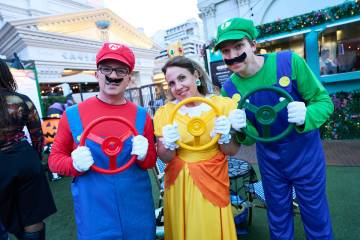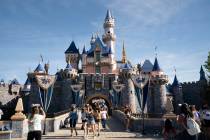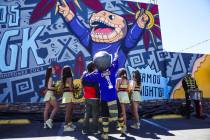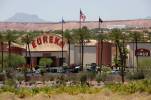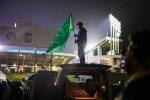Huge outdoor sculpture was dug into the Southern Nevada desert — VIDEO
LOGANDALE — Renowned and reclusive land artist Michael Heizer has nearly finished his vast City inside Basin and Range National Monument, but it could be years before the gates open and the public is allowed to see his remote earthen artwork 150 miles from Las Vegas.
Heizer’s other massive piece of land art in Nevada is as open as it gets.
All it takes to reach “Double Negative” are sturdy tires, some extra ground clearance and a decent map. One dirt road leads to another, rockier dirt road, and there you are: at the eastern edge of Mormon Mesa, staring down into two rectangular trenches — 30 feet wide and 50 feet deep — that face each other across a yawning gap in the plateau.
Taken together, the trenches form an invisible frame more than a quarter of a mile long that cradles in the middle a hulking mass of nothing at all.
You will find no gates there, no signs to explain what you’re looking at or tell you to go away. The Museum of Contemporary Art in Los Angeles owns the artwork and the 60 acres surrounding it, but anyone is free to visit day or night and make of it what they will.
Heizer was the subject of a long profile in The New Yorker last month, and anticipation has swirled for years around his National Mall-sized City, a 44-year, all-consuming endeavor that might not open to the general public until 2020.
Heizer created “Double Negative” in 1969 as a statement on both the nature of sculpture and the business of art. He and his fellow pioneers of the Earth art movement chose to work on the landscape itself, in part because they wanted to create objects (or the absence of them) far too large to hang in a gallery and impossible to collect or sell.
At the time, his cuts in the mesa 70 miles northeast of Las Vegas represented the young artist’s largest and most ambitious work to date.
Bryant Robison, a lifelong resident of nearby Logandale, remembers it well.
“It’s probably the most dangerous construction job I ever did,” the 84-year-old said.
SCULPTING BY BULLDOZER
For decades, Robison ran a small real estate business and a one-man construction company in Moapa Valley. He was sitting in his real estate office one day when two strangers pulled up in a beat-up Winnebago.
“They were a couple of hippies — sandals, long hair, the whole bit,” Robison said.
The men wanted to hire him to dig a pair of trenches on the table-top mesa above town. They marked the site with about eight wooden stakes, and Heizer sketched out what he had in mind.
“I thought they were crazy,” Robison said. “Still not sure they weren’t.”
He told them he would need $10,000 and a copy of their deed for the property before he’d move a single rock.
“I thought I’d never see them again,” he said.
A week later, Robison received a cashier’s check for $10,000 from the Dwan Gallery in New York City.
The entire job took about two months and cost Heizer and his gallery benefactors close to $100,000. Robison did most of the work himself, though he brought in three or four guys to help him with the blasting and the last of the bulldozer work.
Mormon Mesa is topped with 5 to 10 feet of limestone cap rock that had to be drilled and dynamited, Robison said. Once that was out of the way, he dug the trenches using a Caterpillar D8 bulldozer with no canopy.
“You’d look up and see thousands of tons of material above your head. I didn’t own a hardhat. I didn’t know what a hardhat was,” he said. “They’d never let you do a job like that now.”
Each trench is sloped at one end because Robison had to be able to drive the dozer back out of the hole. “That’s as steep as I could make it. The only way I could come out of that thing was to back up,” he said.
At least the job site had a pretty view. “Double Negative” looks out across the shallow braids and curls of the Virgin River to the fractured pyramid of Virgin Peak in the distance.
Robison said Heizer only dropped by once or twice during construction, but he always seemed pleased with the work.
Others weren’t so sure what to make of it.
Robison said an old farmer from Overton stopped by one day to have a look. After staring at the trench for a long while, the man declared in his trademark drawl, “My God that’d hold a lot of silage!”
Once the job was done, Heizer returned with a crew to photograph the finished work. In the years that followed, art lovers from all over the world found their way to Moapa Valley and up onto the mesa.
“I think it probably changed Mike’s lifestyle. It brought him up in the art world,” said Robison, who still chats on the phone with the artist every once in a while.
But even after 47 years, the retired construction worker doesn’t quite understand the point of those famous trenches Heizer had him dig.
Robison said a friend of his with an airplane once flew him over the artwork, not long after it was finished. From the air “it’s pretty impressive,” he said. “But I’m not an artist, so I probably don’t get the whole meaning of it.”
His wife, Darlene, offered her own take: “I think anything can be art if you see it as art,” she said.
FOCUS ON THE NEGATIVE
At about 9:30 a.m. Thursday, a group of eight art lovers, architects and students arrived at “Double Negative” in a pair of dusty SUVs to climb around inside Robison’s execution of Heizer’s idea.
The elements over the past half century have worn the walls ragged and dumped piles of rubble into the trenches, which, per explicit instructions of the artist and the owner, have never been maintained and never will be.
The tour was arranged for Phoenix-based architect and land art aficionado Wendell Burnette, one of the invited speakers at a UNLV symposium Thursday night.
Burnette said he’d been wanting to see “Double Negative” in person for 25 years, so he caught the earliest flight to Las Vegas he could find.
“It doesn’t disappoint,” he said as he photographed and climbed down into the shorter, northern trench.
Melissa Petersen, president of the Las Vegas Contemporary Arts Center, stood near the edge of the trench and talked about its impact. With Heizer’s work, she said, “negative space became a sculptural element.”
The Las Vegas native said she has visited “Double Negative” too many times to count, first as the young daughter of adventurous parents and later as a tour guide and a patron of the arts.
Like any successful piece of contemporary art, this one seems to evoke a strong response in whoever sees it, Petersen said. Some people walk all around and through each trench and spend hours just standing there, contemplating the emptiness in between. Others take one look at Heizer’s holes and ask incredulously, “This is it?”
The answer comes easily to Petersen.
“Yeah,” she says, “this is it.”
Contact Henry Brean at hbrean@reviewjournal.com or 702-383-0350. Follow @RefriedBrean on Twitter.
IF YOU GO
Michael Heizer's Double Negative is located 70 miles northeast of Las Vegas, at the eastern edge of Mormon Mesa. The site is free and open day or night year round, but getting there requires travel over several miles of dirt road. A high clearance vehicle with sturdy tires is recommended.
The Museum of Contemporary Art in Los Angeles offers detailed driving directions on its website, www.moca.org/visit/double-negative.



